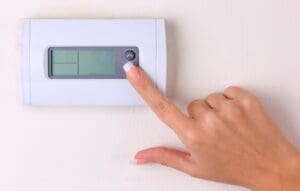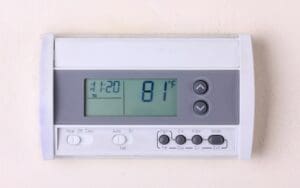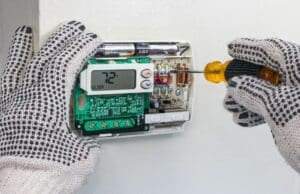
Table of Contents
Suppose your house gets freezing for a reason that is not your fault. On the other hand, you may be trying to turn your thermostat down, and it is not getting warmer. In these cases, you might wonder why your thermostat does not work.
There are quite a few reasons behind your thermostat not working correctly. These signs include the following:
- Circuit breaker issues
- Dead batteries
- It is too old
- Bad wiring
- Programming defects
- Location in the building
- Dirt and debris
This article discusses more in-depth how an AC thermostat works, the common issues you might see, and when you should call a professional. You never know; fixing your thermostat might be as easy as briefly wiping some dust off. However, we will discuss more below. Continue reading for more information.
How Does a Thermostat Work?
Modern thermostats operate electronically using sensors, microprocessors, and programming. Instead of traditional mechanical systems, these thermostats use temperature sensors like thermistors or thermocouples to detect the current temperature. A microprocessor processes the temperature data and compares it to user-set temperature preferences.
The thermostat’s programming allows it to automatically adjust temperatures based on different times of the day. The microprocessor employs algorithms to decide when the heating or cooling system should activate, and it communicates with the HVAC system to send signals for temperature adjustments.
Digital displays and interfaces provide user-friendly interaction while energy-saving features enhance efficiency. These electronic thermostats offer precise temperature control, making them a reliable and modern solution for home climate management.
Common Issues with Thermostats
There are many common issues with the thermostat that you may have yet to think about. For example, if the temperature settings are inaccurate, you must know why and how you can diagnose it. Let us take a look at each issue down below.
Thermostat Not Turning On

Some bad thermostat symptoms can be its refusal to turn on. Sometimes, you have no idea why. In that case, there might be a few possible causes for this.
1. The Thermostat is Old
If you live in an older home, your thermostat might need to retire and go to the junkyard grave. In this case, you may need to invest in a new one.
2. The Batteries Need to Be Replaced
Sometimes, you may not need a thermostat repair. In this case, it might be as simple as battery replacement, especially in a thermostat. The issue is as simple as switching out the batteries in this case. Most thermostats nowadays display a low battery symbol, so check that first before throwing out a good pair.
3. Your Circuit Breaker May Have Some Issues
The circuit breaker is a switch that protects your home from overloading. For example, if you moved appliances around recently and your thermostat stopped working, this might be a clear sign that you need to get an electrician out and help rewire certain things.
Otherwise, your circuit breaker may have a lot of wear and tear. In that case, investing in a new one might ensure your household does not fail.
Inaccurate Temperature Readings

Aside from your thermostat not turning on, it can be as simple as the thermostat’s temperature not working correctly, but why?
1. Incorrect Thermostat Placement
Suppose you have the thermostat right by a bright window or near the door where you constantly come in and out of your home. In that case, it cannot accurately read your home’s temperature, causing inconsistency as direct sunlight will ensure your thermostat does not function correctly. If this is the case, then contact a professional to ensure you get the proper thermostat installation.
2. Your Thermostat Has a Bad Sensor
Like everything in life, thermostats can eventually go wrong, but in this case, we are referring to the sensors which can cause temperature fluctuation. However, replacing the temperature sensor may be challenging, but you can still try a few things beforehand.
First, clean your thermostat’s inside, which is the only thing that needs to be done. A lot of dust can cause your thermostat not to work correctly.
On the other hand, you should recalibrate the sensor, which depends on the type of thermostat you have. In that case, you should call a professional or invest in an entirely new sensor.
3. Not Keeping the Thermostat Level
Older thermostats that have a mercury-based thermostat might not be leveled. In that case, it can cause incorrect temperature settings due to the mercury shifting out of place and needing adjusting. There are two options you can do when it comes to leveling your thermostat:
- Install a new thermostat, as it is a better option overall.
- Reposition your thermostat to help restore its performance.
Thermostat Not Communicating with HVAC System

Thermostats rely heavily on electrical connections to go from point A to B. However, when the system has faulty wiring, the thermostat will not correctly communicate with the HVAC system. Basic thermostats include a cooling, fan, and heating connection, and they may break because of corrosion, loose wiring, or other reasons.
To diagnose, turn off the power breaker and ensure no specific signs of compromised connections. If you notice any corrosion, you will need to remove the corroded wires to display a new selection of wiring.
Programming and Settings Problems

Suppose you or someone who installed the thermostat programmed it wrong. In that case, your thermostat may not work due to the wrong programming and settings.
This issue may be programmed from faulty equipment, wrong mode settings, bad connections, or running on a pre-selected temperature schedule. If you suspect your settings are wrong, you may need to reset the programming.
When to Call a Professional
If you start experiencing the following, call a professional for help.
- Smell or detect a burning odor
- Experience regular circuit outages
- Find signs of deterioration around the circuit breaker
All of these signs might mean a severe underlying issue you may not know about. Ignoring any electrical issues can cause fires or other hazards inside your home. In that case, knowing the difference between a DIY solution and calling someone else is essential. If this is the case, schedule online now; we are available 24/7 and may have some service areas near you. We have multiple home comfort systems that are to your needs.
Book an appointment online with our EZ Book Online button below.
FAQ
Will My AC Still Work If the Thermostat Is Broken?
Yes, your AC will work if the thermostat is broken. On the other hand, you need to ask yourself, “For how long?” This is because a broken thermostat keeps your home’s temperature fluctuating, shortening the life of your AC unit. Not only this, but your electric bill will shoot through the roof.
Is It Safe to Replace Your Own Thermostat?
Replacing your thermostat is unsafe because if you are unsure how to install it properly, you may cause more problems and money in the long run. So, if your profession does not provide you with knowledge on how to change a thermostat or you do not have an electrician or HVAC license, it is best to stay away from doing it yourself.
What Is the Lifespan of a Thermostat?
The lifespan of a thermostat is roughly ten years. However, due to innovations in the market, they are typically replaced sooner. For example, if you have a non-programmable thermostat, it will be replaced with a programmable or talking thermostat, especially if you can control it through your smartphone.



